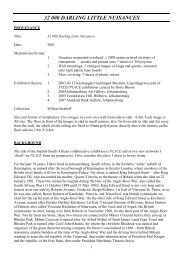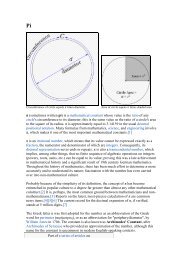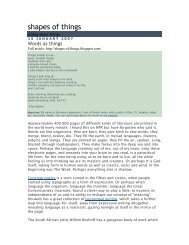Miranthe Staden Garbett Report - Willem Boshoff
Miranthe Staden Garbett Report - Willem Boshoff
Miranthe Staden Garbett Report - Willem Boshoff
You also want an ePaper? Increase the reach of your titles
YUMPU automatically turns print PDFs into web optimized ePapers that Google loves.
A sacred place however must by its very nature transcend literal or scientific<br />
explanations. Spirit is an important component of a sacred place. As a place that elicits<br />
ones attention, demands participation (Korp 1997: 85) and provides opportunity for<br />
mediation or communion, it is the interior world of experience and existentialism that in<br />
this instance takes us beyond the scientific world of objective facts. A sacred place can<br />
be described as “an architectonic space that is enclosed or set aside in some way; it is a<br />
place that has a point of entry, requiring the visitor to go from here to there along some<br />
directed path (Korp 1997:130). A sacred place is animated with ‘energy’ and delineates a<br />
site “where something important happens, where our everyday sense of time and place<br />
collapses” (Korp 1997:30). For these reasons, an architectonic space is “particularly<br />
suited for the plastic realisation of cosmogonic myth, our stories of creation and origin”<br />
in our quest to “know ourselves as earth centred people” ( Korp 1997:10). In fact the<br />
earliest Indo-European word for human, dhghem, means of the earth. As human beings<br />
we have walked the earth for eons, and have collectively known many places of<br />
significance or presence. The role of the artist in facilitating our experience of the sacred<br />
is explained by Korp (1997: 101) artists “are capable of clarifying cosmogenic vision in<br />
order that others may share some aspect of it”.<br />
These aspects of architectonic space and cosmogonic vision apply to Children of the<br />
Stars as do the morphologies of sacred space distinguished by Korp (1997:85). She cites<br />
the foremost authorities, namely Bolle, Higuchi, Norger-Schulz and Eliade who concur<br />
that most sacred places feature an enclosed space, set aside or apart, with a boundary,<br />
a point of entry, a focal point that emits a power or energy and a path which leads us<br />
from here to there, from the ordinary world into the realm of the sacred.<br />
According to Bolle (in Korp 1997: 75) an enclosed space is defined by its boundaries<br />
which may be man-made or natural. Earth and sky might equally enclose a space. In<br />
Children of the Stars, the focal points are the stones themselves. Designed to emulate<br />
asteroids of recent scientific theories, <strong>Boshoff</strong> is well aware of the ancient symbolism<br />
and geomancy of rocks and stones. Rocks and stones have “always held a special








